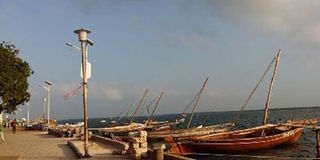Lamu: Swahili town that is E. Africa’s wellness capital

Lamu Island. It is a significant centre for education in Islamic and Swahili culture, and celebrates the annual Maulid and Lamu Cultural Festival (held on January 3-7 this year). PHOTO | NATION MEDIA GROUP
What you need to know:
- It is a UNESCO World Heritage Site whose splendour spreads to Manda and Shela beaches.
- Once among the most important of trade centres in the East Africa, Lamu has exercised religious and cultural influence on the region.
“Lamu is a place I would be interested in visiting (again). It is top on my list. I went there with Michelle after our engagement and I remember taking the dhow to fish, and cooking the fish right at the beach, it was remarkable.”
These are the words of President Barack Obama during the Global Entrepreneurship Summit held in Nairobi mid last year.
Lamu is the oldest surviving Swahili town in East Africa that has retained its original form.
It is a UNESCO World Heritage Site whose splendour spreads to Manda and Shela beaches.
A quick one hour flight from Nairobi sees one landing at the Manda airstrip.
A quick 10-minute boat ride gets you to Lamu town.
The first impression you get of the former city-state its rich heritage.
The stone-town has a rich fusion of African, Arabic and Indian cultures, evident in the style of the Swahili houses.
Once among the most important of trade centres in the East Africa, Lamu has exercised religious and cultural influence on the region.
The island is a significant centre for education in Islamic and Swahili culture, and celebrates the annual Maulid and Lamu Cultural Festival (held on January 3-7 this year).
Other key cultural events include the annual Shela Hat Festival (February 13-14) and The Lamu Yoga Festival (March 2-6 ).
WONDERFUL ACCOMMODATION
Life around the town’s main streets has its own pace.
The donkey remains the main form of transport.
Since the town is not motorised, transportation and other heavy work is done by donkeys.
The massive multi-storey Lamu Fort peaks over the county’s seat of power just by the sea front.
It was built between 1813 and 1821 by the Sultan of Pate.
Additionally, the Lamu Museum, also on the sea front, captures and preserves the history of the town.
The museum showcases an unrivalled collection of ethnographic material from the Swahili, Orma and Pokomo ethnic groups.
Accommodation is plentiful and varied.
The sea front has affordable historic homes for as low as US$50 per night, such as the exquisite Subira House in Lamu old town and Casuarina Rest House.
Swahili and Middle Eastern cuisine is plentiful. You can hop to Manda’s Diamond Beach in minutes aboard Lady Gaga, a popular dhow.




